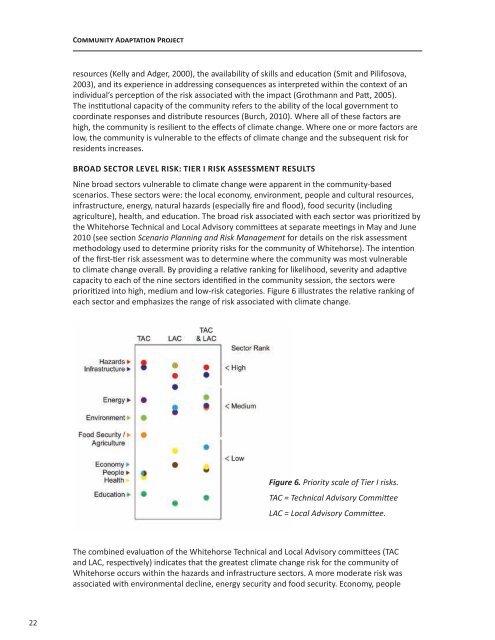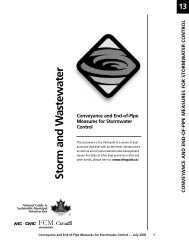Whitehorse Climate Change Adaptation Plan - Yukon College
Whitehorse Climate Change Adaptation Plan - Yukon College
Whitehorse Climate Change Adaptation Plan - Yukon College
You also want an ePaper? Increase the reach of your titles
YUMPU automatically turns print PDFs into web optimized ePapers that Google loves.
22<br />
Community <strong>Adaptation</strong> Project<br />
resources (Kelly and Adger, 2000), the availability of skills and education (Smit and Pilifosova,<br />
2003), and its experience in addressing consequences as interpreted within the context of an<br />
individual’s perception of the risk associated with the impact (Grothmann and Patt, 2005).<br />
The institutional capacity of the community refers to the ability of the local government to<br />
coordinate responses and distribute resources (Burch, 2010). Where all of these factors are<br />
high, the community is resilient to the effects of climate change. Where one or more factors are<br />
low, the community is vulnerable to the effects of climate change and the subsequent risk for<br />
residents increases.<br />
BROAD SECTOR LEVEL RISK: TIER I RISK ASSESSMENT RESULTS<br />
Nine broad sectors vulnerable to climate change were apparent in the community-based<br />
scenarios. These sectors were: the local economy, environment, people and cultural resources,<br />
infrastructure, energy, natural hazards (especially fire and flood), food security (including<br />
agriculture), health, and education. The broad risk associated with each sector was prioritized by<br />
the <strong>Whitehorse</strong> Technical and Local Advisory committees at separate meetings in May and June<br />
2010 (see section Scenario <strong>Plan</strong>ning and Risk Management for details on the risk assessment<br />
methodology used to determine priority risks for the community of <strong>Whitehorse</strong>). The intention<br />
of the first-tier risk assessment was to determine where the community was most vulnerable<br />
to climate change overall. By providing a relative ranking for likelihood, severity and adaptive<br />
capacity to each of the nine sectors identified in the community session, the sectors were<br />
prioritized into high, medium and low-risk categories. Figure 6 illustrates the relative ranking of<br />
each sector and emphasizes the range of risk associated with climate change.<br />
Figure 6. Priority scale of Tier I risks.<br />
TAC = Technical Advisory Committee<br />
LAC = Local Advisory Committee.<br />
The combined evaluation of the <strong>Whitehorse</strong> Technical and Local Advisory committees (TAC<br />
and LAC, respectively) indicates that the greatest climate change risk for the community of<br />
<strong>Whitehorse</strong> occurs within the hazards and infrastructure sectors. A more moderate risk was<br />
associated with environmental decline, energy security and food security. Economy, people

















